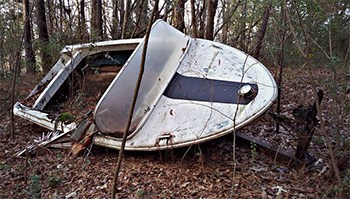With summer just around the corner, you’re having thoughts of getting the boat ready for the water, but how do you de-winterize it properly?
A properly winterized boat is quite easy to get ready for summer fun on the water. It can be as simple as putting the boat plug in, removing the cover, hooking up the batteries, and hitting the lake. For most people though, their boats may require more attention.
Nobody wants to have problems with their boat once the boating season starts. That’s why the end of season maintenance is so important. How people winterize their boat varies, so I’ll cover all summerizing scenarios.
De-winterizing A Properly Winterized Boat
 The best time to be sure all damaged and worn items are repaired, and all maintenance done, is at the end of the boating season. When summer rolls around, you don’t want to have to do a bunch of repairs and maintenance, or waiting for parts to arrive.
The best time to be sure all damaged and worn items are repaired, and all maintenance done, is at the end of the boating season. When summer rolls around, you don’t want to have to do a bunch of repairs and maintenance, or waiting for parts to arrive.
This is why I tell everyone to get their boat in “Ship Shape” during the winterization process. As an example, for me to de-winterize a 20′ stern drive boat that I winterized the year before, these are the steps to summerize it in 15 minutes:
- Remove the cover
- Install the batteries
- Run engine briefly and then check oil level (had to fill oil filter completely)
- Install the drain plug
- Remove moisture absorbing bags
- Remove all the dryer sheets
- Put seat cushions back into place
- Be sure all safety equipment is on board
- Go to the lake!
Any of the boats that I winterize are in the best shape possible when they come out of storage. They are essentially ready for the lake. However, what most people do is the very minimum to get their boat stored for the winter.
Most people are of the mindset that they’re done thinking about boating once the season is over. All they want to do is stick the boat in storage and forget about it until it’s warm and sunny again. The problem is when summer rolls around and they want to go boating, they have work ahead of them. Maybe a lot of work.
I really encourage you to read and bookmark my article on how to properly prepare your boat for extended storage. You’ll be glad you did, and hopefully you share it with your other boating friends.
De-winterizing A Poorly Winterized Boat
 Since many people just worry about how the cold temperatures affect their boat, they only worry about freeze protection before storing their boat. This is a problem, because the longer a boat sits stagnant and unmaintained, the worse the effects on the boat’s running gear.
Since many people just worry about how the cold temperatures affect their boat, they only worry about freeze protection before storing their boat. This is a problem, because the longer a boat sits stagnant and unmaintained, the worse the effects on the boat’s running gear.
Not just that, but if mold and mildew has started, the stagnant nature of storage allows more time for the condition to worsen. This means you will need a much more aggressive cleaning of the material, which does affect the longevity of it.
Here is a list of what may need to be done to a boat that was winterized in a lazy way (which just makes the job more difficult later):
- Remove your cover. If removing shrink wrap, please recycle it, and be careful to not cut your boats fabric during removal.
- Check to see if you sustained any damage from rodents getting into your boat. Repair as needed.
- You may need to clean mold from storage areas and engine bay.
- Check or change your drive’s gear oil.
- Inspect your bellows for any cracking or wear.
- Remove your prop, clean and inspect the prop shaft and bearings, re-grease shaft and reinstall your cleaned prop.
- Install drain plug.
- Check all your cables and connections for slop and stiffness.
- Pump lubricant through your cable housings.
- Check for proper shift engagement at the prop. (learn how to do this and many other tasks on my winterizing article that I mentioned earlier)
- Change engine oil and filter.
- Check power steering fluid.
- Check hydraulic fluid in your trim pump.
- Inspect engine belts for cracking or wear and proper belt tension.
- Check all hose clamps for proper tightness.
- Change the fuel/water separator filter.
- Clean battery terminals and connections.
- Charge and install batteries.
- Clean bilge and insure bilge pump is operating properly.
 Scrub mold and mildew off your vinyl.
Scrub mold and mildew off your vinyl.- Clean and treat your vinyl with a conditioner to protect it from mold, mildew, sun, and dirt.
- Change transmission fluid on inboards and V-drive boats.
- Inspect all wiring for loose connections and corrosion.
- Start engine and check for proper flow from the impeller pump. Replace impeller if needed.
- Check gauges, lights, radio, trim, horn, etc. for proper operation.
- Check engine oil level again after running.
- Clean the boat hull, including any hard deposits on the bottom.
- Repair and nicks or gouges. If there is spider-cracking, have is looked at for structural weakness.
- Apply a quality marine paste wax. It is harder to work with, but leaves an incredible shine and protects longer.
- Clean any PFDs and other gear that was left in the boat. There is most likely going to be some level of mildew on them.
- Clean and vacuum carpeting.
- Be sure that all necessary safety equipment is on board.
- Check pedestal seats for excessive looseness.
- Check all hinged doors, seats, and engine covers for stiff movement, as well as loose screws.
- Clean terminals and check wiring on your trailer.
- Verify proper operation of trailer lights.
- Lubricate and adjust trailer coupler as necessary.
- Check tires for air pressure, sidewall cracking, and tread wear.
- Check for properly adjusted wheel bearings and grease.
Now that’s a lot (39 steps and all the work that goes with each one) to deal with when you could already be out on the water.
 In the future when you’re doing your annual boat maintenance in the fall, you’ll get to relax and enjoy a beautiful spring day, knowing your boat is only 15 minutes of work before dropping in in the lake. But until next year, continue reading and we’ll get through the process together.
In the future when you’re doing your annual boat maintenance in the fall, you’ll get to relax and enjoy a beautiful spring day, knowing your boat is only 15 minutes of work before dropping in in the lake. But until next year, continue reading and we’ll get through the process together.
If you don’t know how to do some of these things, again, it’s all explained in my article on how to properly prepare your boat for extended storage. There are plenty of images and videos to guide your through it all.
Procrastination Never Pays
As you’ll find out, it’s far better to do the proper maintenance in the fall, because:
- it all has to be done anyway.
- there will be less work, to accomplish the same thing, by doing it in the fall.
- there won’t be a worsening of existing problems over the winter.
- you won’t be rushed to get it all done, so you can actually use it.
- when you want to use it in the spring/summer, you could have only 15 minutes of prep, and you’re off to the lake.
But, if it’s boating time and you need to get your boat ready for summer fun, the above list, along with my “Free Checklist To Prepare Your Boat For Extended Storage” article (for the”how to” aspect), will guide you through the process.
Enjoy Your Entire Boating Season
If you choose to do only some of these steps, you greatly increase your odds of a costly and time consuming breakdown right in the middle of your boating season.
Preventative maintenance does take time. But if you do it when the boat is no longer in use, at the end of the boating season, you don’t lose any of your short seasonal boating time. I’m sure it’s not just you that is affected when your boat breaks down.

You probably have a lot of friends and family/kids that really love being out on the boat, enjoying their summer. Don’t miss creating great experiences and memories, just because of skipped maintenance.
When the weather breaks in the spring, you don’t want to dread having to get all the needed maintenance and the de-winterizing done. You want to already have done it the year before, so you can meet the new season with anticipation and excitement.
Here’s to you, for having a better winterization maintenance schedule and enjoying a full and joyfull boating season!


